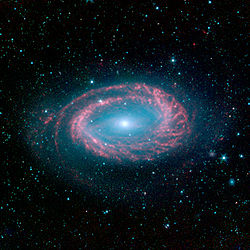| NGC 4725 | |
|---|---|
 NGC 4725 imaged by the Mount Lemmon SkyCenter | |
| Observation data (J2000 epoch) | |
| Constellation | Coma Berenices [1] |
| Right ascension | 12h 50m 26.56929s [2] |
| Declination | +25° 30′ 02.7376″ [2] |
| Heliocentric radial velocity | 1,206±3 km/s [3] |
| Distance | 40.1 ± 6.2 Mly (12.3 ± 1.9 Mpc) [4] |
| Apparent magnitude (V) | 10.1 [3] |
| Characteristics | |
| Type | SAB(r)ab pec [5] or Sb/SB(r)II [6] |
| Size | 150,700 ly (46.23 kpc) (estimated) [3] |
| Apparent size (V) | 9′.77 × 6′.76 [7] |
| Other designations | |
| IRAS 12480+2547, NGC 4725, UGC 7989, LEDA 43451, PGC 43451 [7] [8] | |
NGC 4725 is an intermediate barred spiral galaxy with a prominent ring structure, [9] located in the northern constellation of Coma Berenices near the north galactic pole. [10] It was discovered by German-born British astronomer William Herschel on April 6, 1785. [11] The galaxy lies at a distance of approximately 40 megalight-years [4] from the Milky Way. NGC 4725 is the brightest member of the Coma I Group [12] of the Coma-Sculptor Cloud, although it is relatively isolated from the other members of this group. [6] This galaxy is strongly disturbed and is interacting with neighboring spiral galaxy NGC 4747, with its spiral arms showing indications of warping. The pair have an angular separation of 24′, which corresponds to a projected linear separation of 370 kly. [5] A tidal plume extends from NGC 4747 toward NGC 4725. [10]
Contents

NGC 4725 is a suspected type 2 Seyfert galaxy with a supermassive black hole at the core. [13] The morphological classification of this galaxy is SAB(r)ab pec, [5] indicating a peculiar, weakly-barred spiral galaxy (SAB) with a complete ring surrounding the bar (r) and somewhat tightly-wound spiral arms (ab). It is actually double-barred, a feature found among about a third of all barred spirals. [14] The galactic plane is inclined by approximately 46° to the line of sight from the Earth. [6]
The ring structure of the galaxy is a region of star formation. It is offset from the galactic center and displays non-circular motion. [15] There is a compact radio source positioned approximately 6.2 kly from the nucleus of NGC 4725. Since there is no optical counterpart at that position, this may be a star forming region that is heavily obscured by dust. [9]